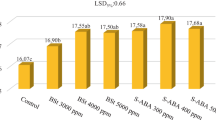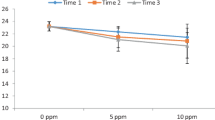Abstract
Phenolic compounds and anthocyanins had pivotal roles on wine grape quality. In order to enhance contents of these substances, several techniques have been applied to grapevines. In recent years, there has been an increasing concern about using of foliar oak applications for improving wine grape quality. In this study, it was used a low concentration (0.6%) of urea for increasing efficiency of different doses of oak applications. For this aim, it was benefited from different doses of foliar oak applications with or without urea, including: 0 ppm oak (Oa), 1250 ppm oak (Oa), 2500 ppm (Oa), 5000 ppm (Oa), 0 ppm oak (Oa) + 0.6% Urea (Ur), 1250 ppm oak (Oa) + 0.6% Urea (Ur), 2500 ppm oak (Oa) + 0.6% Urea (Ur), 5000 ppm oak (Oa) + 0.6% Urea (Ur). Although yield and wine grape quality characteristics were favorably affected by increasing doses of oak applications; urea added oak applications were especially found to be more effective for both characteristics. As a result, application of 5000 ppm oak (Oa) + 0.6% Urea (Ur) led to best results in terms of yield and wine grape characteristics of cv. Cabernet Sauvignon.






Similar content being viewed by others
References
Amone K, Simonetti-Bryan J (2013) Pairing with the masters: a definitive guide to food and wine. Delmar, New York. ISBN 978-1-111-54384-6
Bell SJ, Henschke PA (2005) Implications of nitrogen nutrition for grapes, fermentation and wine. Aust J Grape Wine Res 11(3):242–295
Botes MP (2009) Evaluation of parameters to determine optimum ripeness in Cabernet Sauvignon grapes in relation to wine quality. Master thesis, Stellenbosch University, South Africa, p 111
Bouzas-Cid Y, Portu J, Perez-Alvarez EP, Gonzalo-Diago A, Garde-Cerdan T (2016) Effect of vegetal ground cover crops on wine anthocyanin content. Sci Hortic 211:384390
Butzke CE (2010) Winemaking problems solved. CRC, Boca Raton
Cooke GM (2004) Making table wine at home. Agriculture and natural resources. Publication 21434. University of California, Oakland
Coombe BG, Dundon RJ, Short AW (1980) Indices of sugar-acidity as ripeness criteria for wine grapes. J Sci Food Agric 31:495–502
Delgado R, Martin P, Del Alamo M, Gonzalez MR (2004) Changes in the phenolic composition of grape berries during ripening in relationship to vineyard nitrogen and potassium fertilisation rates. J Sci Food Agric 84:623–630
Downey MO, Dokoozlian NK, Krstic MP (2006) Cultural practice and environmental impacts on the flavonoid composition of grapes and wine. A review of recent research. Am J Enol Vitic 57:257–268
Gougoulias N (2010) Study on phenolics and antioxidant activity of selected wines from some Greek Aegean Sea islands. Oxid Commun 33(1):167–174
Gougoulias N, Masheva L (2010) Effect of gibberellic acid (GA3) on polyphenols content and antioxidative activity of some table grape varieties. Oxid Commun 33:652–660
Janick J, Paull RE (2008) The encyclopaedia of fruit and nuts. Cambridge University Press, Reading. ISBN 978-0-85199-638-7
Kok D (2011) Influences of pre and post-verasion cluster thinning treatments on grape composition variables and monoterpene levels of Vitis vinifera L. Cv. Sauvignon Blanc. J Food Agric Environ 9(1):22–26
Kok D (2016) Variation in total phenolic compounds, anthocyanin and monoterpene content of ‘Muscat Hamburg’ table grape variety (V. vinifera L.) as affected by cluster thinning and early and late period basal leaf removal treatments. Erwerbs-Obstbau 58:241–246
Kok D (2017) Assessment of electrochemical attribute and monoterpene content of twelve aromatic grape cultivars (V. vinifera L.) grown under the ecological conditions of north-western Turkey. Oxid Commun 40(1-II):557–564
Kok D, Bal E (2016) Seedless berry growth and bioactive compounds of cv. ‘Recel Uzümü’ (V. vinifera L.) as affected by application doses and times of pre-harvest thidiazuron. Erwerbs-Obstbau 58:253–258
Kok D, Bal E (2017a) Compositional differences in phenolic compounds and anthocyanin contents of some table and wine grape (V. vinifera L.) varieties from Turkey. Oxid Commun 40(2):648–656
Kok D, Bal E (2017b) Leaf removal treatments combined with kaolin film technique from different directions of grapevine’s canopy affect the composition of phytochemicals of cv. Muscat Hamburg (V. vinifera L.). Erwerbs-Obstbau. https://doi.org/10.1007/s10341-017-0337-7
Kok D, Bal E, Celik S (2013) Influences of various canopy management techniques on wine grape quality of V. vinifera L. cv. Kalecik Karası. Bulg J Agric Sci 19(6):1247–1252
Linskens HF, Jackson JF (1988) Wine analysis. Springer, Berlin. ISBN 978-3-642-83342-7
Martinez-Gil AM, Garde-Cerdan T, Martinez L, Alonso GL, Salinas MR (2011) Effect of oak extract application to Verdejo grapevines on gape and wine aroma. J Agric Food Chem 59(7):3253–3263
Martinez-Gil AM, Garde-Cerdan T, Zalacain A, Pardo-Garcia AI, Salinas MR (2012) Applications of an oak extract on Petit Verdot grapevines. Influence on grape and wine volatile compounds. Food Chem 132(4):1836–1845
Martinez-Gil AM, Angenieux M, Pardo-Garcia AI, Alonso GL, Ojeda H, Salinas MR (2013) Glycoside aroma precursors of Syrah and Chardonnay grapes after an oak extract application to the grapevines. Food Chem 138(2):956–965
Packer L (2002) Handbook of antioxidants. Marcel Dekker Inc., New York. ISBN 978-0-8247-0547-5
Pardo-Garcia AI, Martinez-Gil AM, Cadahia E, Pardo F, Alonso GL, Salinas M (2014) Oak extract application to grapevines as a plant biostimulant to increase wine polyphenols. Food Res Int 55:150–160
Portu J, Gonzalez-Arenzana L, Hermosin-Gutierrez I, Santamaria P, Garde-Cerdan T (2015) Phenylalanine and urea foliar applications to grapevine: effect on wine phenolic content. Food Chem 180:55–63
Singleton VL, Timberlake CF, Kea L (1978) The phenolic cinnamates of white grapes and wine. J Sci Food Agric 29:403–410
Soubeyrand E, Basteau C, Hilbert G, Van Leeuwen C, Delrot S, Gomes E (2014) Nitrogen supply affects anthocyanin biosynthetic and regulatory genes in grapevine cv. Cabernet Sauvignon berries. Photochemistry 103:38–49
Stefano R di, Cravero MC (1991) Metodi per lo studio dei polifenoli dell’uva. Riv Vitic Enol 2:37–45
Tokuşoğlu Ö, Hall CA (2010) Fruit and cereal bioactives: Sources, chemistry and application. CRC Press, Boca Raton. ISBN 978-1-4398-0667-8
Author information
Authors and Affiliations
Corresponding author
Ethics declarations
Conflict of interest
D. Kok declares that he has no competing interests.
Rights and permissions
About this article
Cite this article
Kok, D. Changes in Phenolic Compounds Profile and Anthocyanin Content of cv. Cabernet Sauvignon (V. vinifera L.) Induced by Different Doses of Foliar Oak Applications with Urea. Erwerbs-Obstbau 60 (Suppl 1), 71–77 (2018). https://doi.org/10.1007/s10341-018-0405-7
Received:
Accepted:
Published:
Issue Date:
DOI: https://doi.org/10.1007/s10341-018-0405-7
Keywords
- Vitis vinifera L.
- Wine grape
- Foliar oak application
- Foliar urea application
- Phenolic compounds
- Anthocyanins




